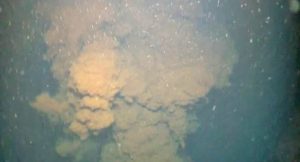Study Improves Tracking and Forecasting of Underwater Oil Plumes
– August 4, 2014
Scientists from the University of Miami Rosenstiel School of Marine and Atmospheric Science and the Technical University of Hamburg-Harburg used models, lab experiments, and observations from the Deepwater Horizon oil spill to evaluate the importance of variables in oil transport and fate models, particularly those influencing underwater plume development.
Factors that affected the time oil stayed in the water column were key and included oil droplet size, variable oil flow rates from the wellhead, vertical current velocity, and high-pressure biodegradation. The researchers incorporated these parameters into a three-dimensional deep plume model; they published their findings in the January 2014 online issue of Deep Sea Research Part II: Topical Studies in Oceanography: Simulating the effects of droplet size, high-pressure biodegradation, and variable flow rate on the subsea evolution of deep plumes from the Macondo blowout.
Over the course of the Deepwater Horizon event, about 22% of the oil would reach the surface leaving the rest in the water and sediments. Scientists encountered large underwater plumes at 800 – 1200 meters depth but had difficulty tracking or predicting their movement. At the time, little was known about the impacts of pressure, temperature, ocean dynamics, and geochemical processes on subsea dispersed oil. While the spill was tragic, researchers used this opportunity to learn about the effects these conditions have on deep water oil plume formation and improve plume tracking and prediction.
Researchers developed a three-dimensional model using the Connectivity Modeling System (CMS), which included biodegradation data from high-pressure experiments, and the Gulf of Mexico Hybrid Coordinate Ocean Model (GoM-HYCOM), which included inputs for stratification, currents, temperature, and salinity data. They added an oil module to track oil droplets with multiple hydrocarbon fractions based on Macondo oil chemistry. Daily oil flow rate input were based on direct measurements from the reservoir and blowout preventer pressures, which included effects from wellhead alterations during capping attempts.
Simulations showed that the various flow rates before the well was capped contributed to the formation of the subsea oil plume and to its persistence after capping, as flow rates affected droplet size. Droplets smaller than 50 micrometers were nearly neutrally buoyant, extending their time in the deep plume; only vertical flows could cause these droplets to rise very slowly into the upper ocean layers. The oil droplets’ increased suspension also extended exposure to the seafloor as the plume swept across the ocean bottom. Larger oil droplets up to 100 micrometers created additional, more-shallow plumes because the different water densities slowed their assent.
The team found that incorporating the oil’s varying flow rates and high-pressure biodegradation rates improved the model’s alignment with field observations, especially the plume’s recorded southwest branch. Variable flow rate data also improved accuracy of oil droplet size and density and captured water column stratification more realistically. The timing of oil releases suggests that droplets do not have the same age and can be various sizes and densities at different depths.
Adding vertical velocities and high-pressure biodegradation data to flow rate changed the model’s predicted average depth of the oil mass center from 1149 meters to 1274 meters, which aligns better with observed data. Predictions using high-pressure biodegradation data improved with time, suggesting an initial lag in bacterial degradation which agrees with the lag between the blowout and observed biodegradation.
This novel implementation of the CMS oil module more accurately modeled initial conditions and enhanced the deep plume coherence, capturing the major far-field processes involved in the blowout and more of the flow variability in the near-field. Comparing oil simulations with in situ observations showed that adding high-pressure biodegradation rates to the model improved oil path predictions. The researchers recommended that further study on seafloor oil deposits could improve the CMS modeling capabilities to assess the long-term footprint on the seafloor marine ecosystem.
The study’s authors are D. Lindo-Atichati, C.B. Paris, M. Le Hénaff, M. Schedler, A.G. Valladares Juárez, and R. Müller.
This research was made possible in part by a grant from BP/The Gulf of Mexico Research Initiative (GoMRI) to the Center for Integrated Modeling and Analysis of Gulf Ecosystems (C-IMAGE). The GoMRI is a 10-year independent research program established to study the effect, and the potential associated impact, of hydrocarbon releases on the environment and public health, as well as to develop improved spill mitigation, oil detection, characterization and remediation technologies. An independent and academic 20-member Research Board makes the funding and research direction decisions to ensure the intellectual quality, effectiveness and academic independence of the GoMRI research. All research data, findings and publications will be made publicly available. The program was established through a $500 million financial commitment from BP. For more information, visit https://gulfresearchinitiative.org/.
© Copyright 2010- 2017 Gulf of Mexico Research Initiative (GoMRI) – All Rights Reserved. Redistribution is encouraged with acknowledgement to the Gulf of Mexico Research Initiative (GoMRI). Please credit images and/or videos as done in each article. Questions? Contact web-content editor Nilde “Maggie” Dannreuther, Northern Gulf Institute, Mississippi State University (maggied@ngi.msstate.edu).






